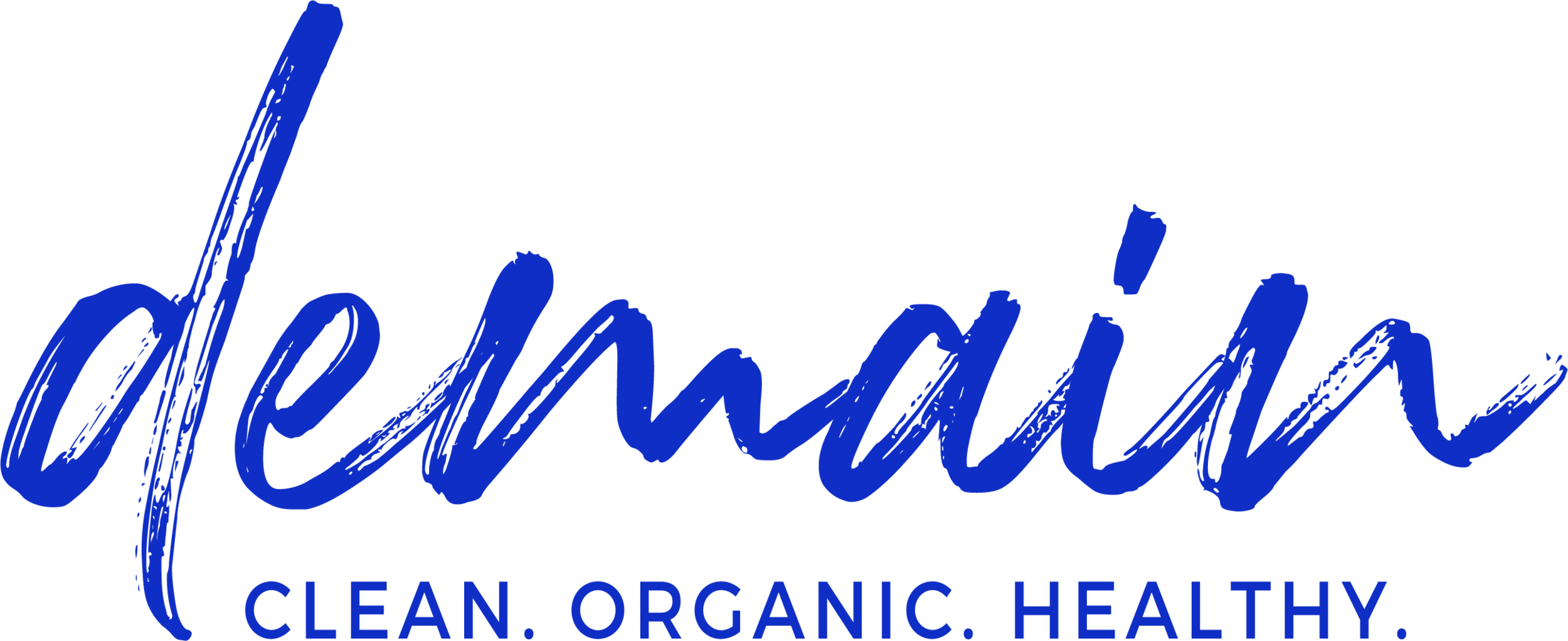THE CLEAN CHARTER
At Demain®, your health is our priority.
We have therefore chosen to only include in our products ingredients that are 100% healthy for your skin and your body.
Our cosmetic formulas are 100% natural, certified organic by Ecocert and are enriched with prebiotics and probiotics to preserve your microbiota.
They do not contain any chemicals, endocrine disruptors or carcinogens or other ingredients that are stripping, irritating or harmful to your skin microbiota, while guaranteeing sensoriality and effectiveness!
You will therefore find no parabens, PEGs, silicones, phthalates or controversial preservatives in our formulas.
Here is the list of ingredients that you will never find in a Demain® cosmetic product:

ENDOCRINE DISRUPTORS:
Phenoxyethanol: Preservative. It is easily absorbed through the skin, it is prohibited for children under 3 years old on products intended for the seat and it is suspected of being an endocrine disruptor (harmful for hormonal balance, which can lead to cases of sterility). Tolerated by the regulations at 1% in adults, we fear the cocktail effect of this ingredient present in the majority of conventional cosmetics.
Parabens: Used as preservatives in many formulas, parabens starting with P or B (like Pas Bon) are endocrine disruptors.
Silicones (dimethicone, cyclopentasiloxane, cyclomethicone): Used to provide slip to formulas, silicones are suspected of being endocrine disruptors. Derived from plastic, very poorly biodegradable, they pollute the environment by leaching into wastewater...
Ethylhexyl Methoxycinnamate (or octyl methoxycinnamate): This compound is an anti-UV filter found in cosmetic products other than sun creams such as day creams or foundations. It is considered an endocrine disruptor.
Phthalates (dibutyl phthalates, DBP, DEHP, DEP): Fixing agents. They thus allow perfumes to last longer or prevent varnishes from flaking and they are suspected of being endocrine disruptors.
BHA (Butylhydroxyanisole): This is an antioxidant used to prevent the rancidity of fatty substances. It is suspected of being an endocrine disruptor. It is classified as a possible carcinogen by the IARC (International Agency for Research against Cancer) and is also said to have a toxic effect.
BHT (Butylhydroxytoluene): Also antioxidant. It is mainly used to replace BHA. BHT would also be an endocrine disruptor and would also have other more toxic effects on the liver, kidneys or lungs.

Butylene-Glycol: Humectant, when it comes from petrochemicals, it is suspected of being irritating or even toxic and can cause reproductive disorders. In addition, it is non-biodegradable.
Propylene-Glycol: Preservative. It is suspected of being carcinogenic and of causing reproductive disorders. Not biodegradable.
Benzophenone: Photo-sensitiser, suspected of being an endocrine disruptor and highly allergenic.
Triclosan: A powerful antimicrobial (often found in toothpastes and antibacterial soaps), it is suspected of being an endocrine disruptor, irritating to skin and eyes and very toxic to aquatic organisms.

IRRITANT AND ALLERGENIC INGREDIENTS:
Sulfates including Sodium Lauteth Sulfate (SLS): A synthetic sulfur-based ingredient and foaming agent found in many rinse-off products that can be harsh and irritating to the skin.
Toluene: Volatile solvent, pollutant, irritating to skin, eyes and respiratory system.
Methylisothiazolinone (MIT): Powerful preservative, often used to replace parabens, but which is irritating and can cause contact dermatitis.
P-phenylenediamine and its derivatives: Present in permanent hair coloring and temporary tattoos. These are ingredients known as sensitizers and likely to cause major allergies. Many cases of eczema have been reported among users and hairdressers.

CARCINOGENIC INGREDIENTS:
PEG: Derived from petroleum, PEGs are used as thickeners, emulsifiers, surfactants or humectants. Although commonly used in cosmetics or shampoos, PEGs are suspected of being carcinogenic and are also very poorly biodegradable. They accumulate in nature through wastewater runoff.
Mineral oils, including paraffin oil: Derived from petrochemicals, purely synthetic, they are widely used in cosmetics, because they are less expensive than vegetable oils. They have no nutritional quality for the skin. Worse, they are occlusive and prevent the skin from breathing. Depending on their degree of refining, they are likely to be carcinogenic to humans.
Formaldehyde: Preservative suspected of being carcinogenic.
DEA/MEA/TEA: Foaming agents and agents for creating creamy textures. Potentially carcinogenic substance and can cause irritation.
To learn more about clean beauty, check out our article: Clean beauty: naturally healthy skin .
AND FOR PERFUMES?
For your pleasure and well-being, we have also chosen sensoriality over neutrality for our formulas and have therefore decided to perfume the majority of our products with 100% natural fragrances, although cosmetic analysis applications classify certain natural fragrance ingredients as risky ingredients.

WHAT ARE PERFUME ALLERGENS?
Perfume allergens are molecules naturally present in fragrance substances that can cause allergic reactions in people who are sensitive to them. These are not ingredients that the manufacturer voluntarily adds to the formula, but substances contained in the ingredients that make up the perfume. Due to their allergenic nature, some of these substances are regulated in order to limit the risks of contact allergies for consumers. Dosage, labels to be affixed to cosmetics... Everything is strictly regulated.

WHAT ARE THE RISKS ASSOCIATED WITH PERFUME ALLERGENS?
The risks associated with perfume allergens are risks of irritation or allergies only for people sensitive to these substances : redness, itching, etc.
We cannot therefore speak of “danger” , as we would for ingredients known to be carcinogenic, for example. As these risks of reactions are quite limited, the mention of these ingredients in the INCI lists has more of an informative rather than a health purpose. The aim is to facilitate their detection for sensitive people. The CSSC has also published an information sheet explaining that 1 to 3% of the European population have declared an allergy due to perfumery ingredients.
In conclusion, we can say that perfume allergens are to cosmetics what nuts are to food products. They are mentioned on the packaging to secure people who do not support them, but they are not dangerous for non-allergic people. In food, the presence of these allergens does not affect the overall score of the product.







